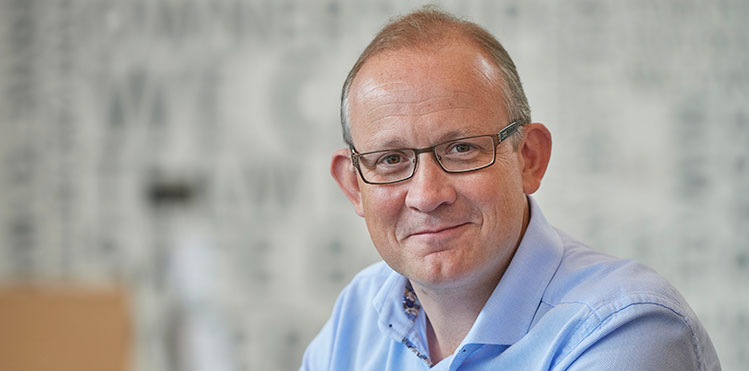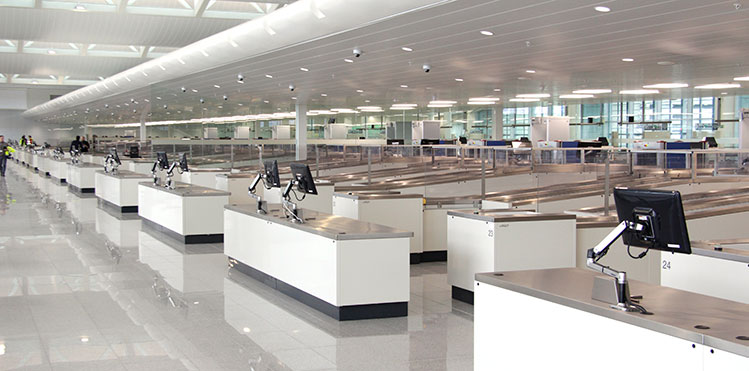Andrew Manship, Executive Vice President Airports and Board Member, Vanderlande, interviewed by Ross Falconer.

Andrew Manship, Executive Vice President Airports and Board Member, Vanderlande: “Vanderlande’s APC solution is a seamless system that combines a modular, state-of-the-art automated security lane with remote screening.”
Alongside its successful Advanced Passenger Checkpoint (APC) projects at Las Vegas and Keflavik airports, Vanderlande is working on the integration of its SCANNOJET tray return systems and eVelocity centralised image processing (CIP) software at Prague Airport.
As part of a major redevelopment of Terminal 2, Prague is installing a 12-lane centralised security area that will open this summer. “Prague has invested in eight 18m SCANNOJET systems in combination with eVelocity software. The latter will initially be used to perform localised searches at the checkpoints, and, at a later stage, Prague will use a fully remote screening facility,” explains Andrew Manship, Executive Vice President Airports and Board Member, Vanderlande. “Vanderlande’s APC solution is a seamless system that combines a modular, state-of-the-art automated security lane with remote screening. This will allow Prague’s screening agents to share the workload, counter the effects of traffic variation, and significantly improve their operational efficiency.”
Flexibility and space efficiency are key to future-proofing baggage logistics, and Vanderlande aims to provide both with FLEET – a new logistic solution for baggage handling.
“By utilising intelligent automated vehicle technology, FLEET replaces the need for massive amounts of fixed conveyors and sorting systems,” says Manship. “The intelligent software, in combination with advanced, predictive data analytics, enables continuous adaptation to changing customer demands. Furthermore, we’re rethinking the way to deliver this solution to the market, more as a flexible logistic service than a fixed transactional delivery. Moreover, with FLEET, we’re pushing ourselves to bring sustainability to the next level. FLEET uses 50% less energy and we take responsibility to use regenerative natural resources.”

Alongside its successful Advanced Passenger Checkpoint projects at Las Vegas and Keflavik airports, Vanderlande is working on the integration of its SCANNOJET tray return systems and eVelocity centralised image processing software at Prague Airport.
The first FLEET project will be implemented at Rotterdam The Hague Airport, with the new solution allowing the airport to change seamlessly in the future to match its business requirements.
Scalability is also possible by implementing additional vehicles. “In this way, the system has been designed to grow alongside the airport, without impacting on operations or necessitating any immediate building expansion,” Manship notes. “In addition, FLEET consumes up to 50% less energy compared to a traditional baggage handling system. When comparing costs during 10 years of operation, including initial investments, FLEET offers smaller/regional airports automatic sortation for the price of a conventional baggage handling system with manual sortation. This results in greater operational efficiencies, quality, and ergonomics.”
Meanwhile, Taiwan Taoyuan International Airport (TTIA) recently selected Vanderlande for the baggage handling contract for its Terminal 3 project. It will be an important step in developing
Vanderlande’s individual carrier system (ICS) capabilities in the Asia-Pacific region. Vanderlande’s solution will provide a baggage handling system with a maximum capacity of 19,200 bags per hour. The airport’s two existing terminals are currently operated individually without a connection between the two systems. “Once T3 has been constructed, all terminals will be seamlessly connected with Vanderlande’s automated ICS – TUBTRAX,” Manship explains. “This will result in a significant improvement to TTIA’s operational efficiency and tracking accuracy, as well as enhancing the experience for passengers.”
The baggage handling system in T3 will comprise 206 check-in counters distributed over six islands. Baggage will be transferred from the check-in area via the transport conveyors connected to four tilt tray sorters located at the main baggage hall. Bags will then pass through security screening before transfer to either the designated make-up carousels, early bag store area, or other terminals via TUBTRAX.







